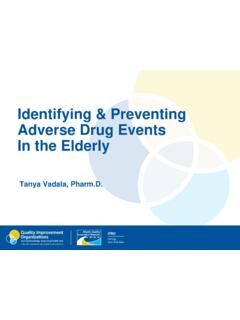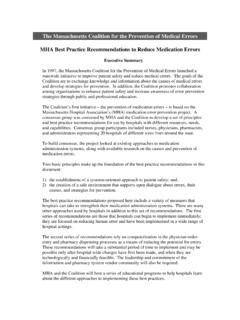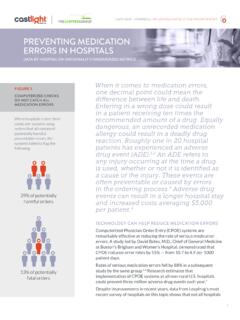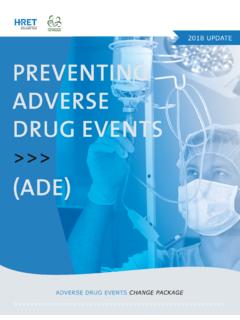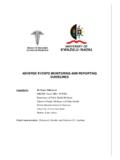Transcription of Adverse Drug Event Prevention: Diabetes and Opioids
1 Adverse drug Event prevention : Diabetes and Opioids Introduction This National Action Plan for Adverse drug Event prevention (ADE Action Plan) seeks to engage all stakeholders in a coordinated, aligned, multisector, and health-literate effort to reduce the ADEs that are most common, clinically significant, preventable, and measurable. The ADE Action Plan identifies the Federal Government's highest priority strategies and opportunities for advancement, which will have the greatest impact on reducing ADEs. Implementation of these strategies is expected to result in safer and higher quality health care services, reduced health care costs, informed and engaged consumers, and ultimately, improved health outcomes.
2 The Office of Disease prevention and Health Promotion (ODPHP), in conjunction with the Federal Interagency Steering Committee and Workgroups for ADEs, led the development of the ADE Action Plan. Specifically, representatives of as many as 13 Federal Agencies and non-Federal subject matter expert consultants contributed to the ADE Action Plan, to draw attention to ADEs as a major patient safety and public health issue. The ADE Action Plan provides Federal Agencies and external stakeholders with a framework to identify strategies and select specific actions to take. The intended end users of the Action Plan are policymakers, health care professionals, public and private sector organizations, and communities that can organize and take action toward preventing high-priority ADEs.
3 The ADE Action Plan is organized into seven sections. The first four sections outline the scope and development of the ADE Action Plan, identify Federal surveillance resources to measure and monitor the burden of ADEs, describe overall prevention approaches by identifying key determinants of ADEs, and review incentives and oversight opportunities to prevent ADEs. The next three sections of the ADE. Action Plan address in detail the high-priority ADE targets (anticoagulants, Diabetes agents, and Opioids ). that are the focus of the ADE Action Plan, highlighting the most pertinent actions to potentially advance each of the areas of surveillance, evidence-based prevention tools, incentives and oversight, and research (unanswered questions), as well as the role of health information technology (health IT) in advancing these efforts.
4 Some of these sections provide recommendations or information that informs other areas. The final section presents conclusions and outlines next steps. National Action Plan for Adverse drug Event prevention | 4. Introduction Adverse drug events : Magnitude of the Problem ADE prevention Is a Patient Safety Priority An Adverse drug Event has been defined by the Institute of Medicine as an injury resulting from medical intervention related to a drug [1]. This broad term encompasses harms that occur during medical care that are directly caused by the drug including but are not limited to medication errors, Adverse drug reactions, allergic reactions, and overdoses [1] [Figure 1].
5 A medication error is defined as inappropriate use of a drug that may or may not result in harm; such errors may occur during prescribing, transcribing, dispensing, administering, adherence, or monitoring of a drug [2,3]. In contrast, an Adverse drug reaction (ADR) is harms directly caused by a drug at normal doses [3]. Figure 1. Terms Relevant to drug -Related Harm [2]. Adverse drug events (all blue areas). Medication Errors Adverse drug Reactions (dark blue area only). A large majority of ADEs are preventable. In 2006, 82 percent of the United States population reported using at least one prescription medication, over-the-counter medication, or dietary supplement, and 29.
6 Percent reported using five or more prescription medications [4]. Among older adults (65 years of age or older), 57 59 percent reported taking five to nine medications and 17 19 percent reported taking 10. or more over the course of that year [4]. Given the population's large and ever-increasing magnitude of medication exposure, the potential for harms from ADEs constitutes a critical patient safety and public health challenge. ADEs can occur in any health care setting, including inpatient ( , acute care hospitals), outpatient, and institutional and noninstitutional long-term care (LTC) settings ( , nursing homes, group homes). The likelihood of ADEs occurring may also increase during transitions of care ( , discharge from a hospital to a nursing home or patients' move from one health care provider or setting to another), when National Action Plan for Adverse drug Event prevention | 5.
7 Introduction information may not be adequately transferred between health care providers [5] or patients may not completely understand how to manage their medications [6, 7, 8]. In inpatient settings, research indicates that ADEs are among the largest contributors to hospital-related complications [9, 10]. It has been estimated that ADEs comprise one-third of hospital Adverse events [9], affect approximately 2 million hospital stays annually [9, 11], and prolong hospital length of stay by approximately to days [11, 12, 13]. Data regarding how ADEs contribute to postdischarge complications or during other types of care transitions are lacking. One single-center study based in a tertiary care academic medical center identified ADEs as the most common cause of postdischarge complications occurring within 3 weeks of hospital discharge (accounting for two-thirds of postdischarge complications) [14]; in this study, 24 percent of postdischarge ADEs were judged to be preventable, and in another, similar study, 27 percent of postdischarge ADEs were judged to be preventable and 33 percent ameliorable [15].
8 In outpatient settings, nationally representative surveillance data indicate that ADEs account for more than million physician office visits [16], an estimated 1 million emergency department (ED) visits [17], and approximately 125,000 hospital admissions each year [17]. An analysis of 2011 data indicated that ADEs were three times more likely to be present on admission than during the hospital stay [18]. The economic impact of ADEs has been inadequately studied. Older data indicate that ADEs impose a large financial burden on health care expenditures [12, 13]; one study estimated ADEs incurred $ million (1993 USD) in excess hospital costs [12]. National estimates suggest that ADEs contribute an additional $ billion (2006 USD) to health care costs [19].
9 Older adults experience the highest population rates of ADEs resulting in ED visits and are seven times more likely than younger persons to have an ADE that requires emergent hospital admission [16, 20]. Analysis of 2011 data indicated that Medicare beneficiaries are at the highest risk of acquiring an ADE during a hospital stay with Medicare reimbursing 75 percent of inpatient ADEs attributable to the most common medications [20]. These ED. visits and hospital admissions from ADEs, a significant number of which are considered preventable, contribute to an enormously overburdened Medicare system [9]. Focus on High-Impact Targets and Populations The National Action Plan for Adverse drug Event prevention focuses on common, clinically significant, preventable, and measurable ADEs.
10 A key group of ADEs are particularly dangerous and largely preventable, and for these reasons, they are high-priority targets for national and local ADE prevention efforts. National Action Plan for Adverse drug Event prevention | 6. Introduction Medication Classes Most Commonly Implicated in ADEs In a nationally representative sample of hospitalized Medicare beneficiaries, the targets of the ADE. Action Plan were identified as three of the most commonly implicated drug classes in ADEs: anticoagulants, Opioids , and insulin [9]. Conservative estimates indicate that hospitalized patients experience 380,000 to 450,000 ADEs each year, with a large majority of these attributable to anticoagulants and Opioids [17].











